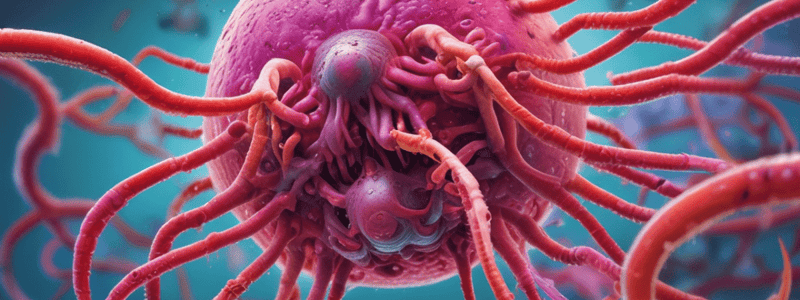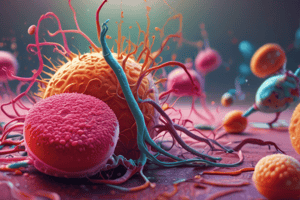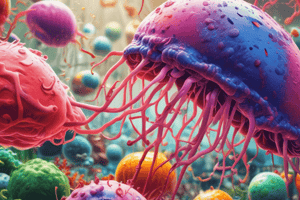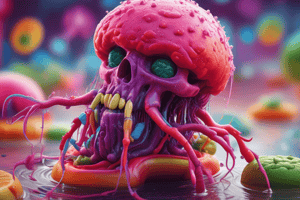Podcast
Questions and Answers
What is the primary characteristic of Staphylococcus aureus that causes Staphylococcal Food Intoxication?
What is the primary characteristic of Staphylococcus aureus that causes Staphylococcal Food Intoxication?
- It is an obligate anaerobe that produces endospores
- It produces a heat-labile neurotoxin
- It produces a heat-stable enterotoxin (Type I exotoxin) (correct)
- It is a gram-negative bacterium found on human skin
Which disease is caused by the bacterium Clostridium botulinum and its characteristic toxin?
Which disease is caused by the bacterium Clostridium botulinum and its characteristic toxin?
- Salmonellosis
- Botulism (correct)
- Shigellosis
- Hemorrhagic Colitis
Which disease is characterized by bloody diarrhea and is associated with the use of antibiotics or antiprotozoal drugs?
Which disease is characterized by bloody diarrhea and is associated with the use of antibiotics or antiprotozoal drugs?
- Typhoid Fever
- Salmonellosis
- Bacterial Gastroenteritis
- Clostridium difficile-Associated Diarrhea (correct)
Which disease is caused by a serovar (strain) of Salmonella that multiplies within phagocytes and has a long incubation period of weeks?
Which disease is caused by a serovar (strain) of Salmonella that multiplies within phagocytes and has a long incubation period of weeks?
Which disease is caused by a bacterium that produces Shiga toxin and can lead to Hemolytic Uremic Syndrome (HUS)?
Which disease is caused by a bacterium that produces Shiga toxin and can lead to Hemolytic Uremic Syndrome (HUS)?
Which disease is often referred to as 'Traveler's diarrhea' and is caused by a motile, coliform bacterium that produces an enterotoxin?
Which disease is often referred to as 'Traveler's diarrhea' and is caused by a motile, coliform bacterium that produces an enterotoxin?
Which disease is caused by a bacterium that possesses fimbriae and multiplies within the epithelial cells of the gastrointestinal tract?
Which disease is caused by a bacterium that possesses fimbriae and multiplies within the epithelial cells of the gastrointestinal tract?
Which disease is characterized by a low percentage (1-3%) of chronic carriers and is transmitted through fecal-oral contamination of water or food?
Which disease is characterized by a low percentage (1-3%) of chronic carriers and is transmitted through fecal-oral contamination of water or food?
Which of the following is a characteristic of the cholera bacterium, Vibrio cholerae?
Which of the following is a characteristic of the cholera bacterium, Vibrio cholerae?
What is the primary route of transmission for hepatitis A virus (HAV)?
What is the primary route of transmission for hepatitis A virus (HAV)?
Which of the following viruses is known to cause poliomyelitis, a disease characterized by limb paralysis?
Which of the following viruses is known to cause poliomyelitis, a disease characterized by limb paralysis?
Which of the following is a characteristic of the protist Giardia intestinalis, the causative agent of giardiasis?
Which of the following is a characteristic of the protist Giardia intestinalis, the causative agent of giardiasis?
Which of the following statements about prion diseases is correct?
Which of the following statements about prion diseases is correct?
Which of the following is the adult stage of the beef tapeworm infection?
Which of the following is the adult stage of the beef tapeworm infection?
Which of the following diseases is caused by an amoeba?
Which of the following diseases is caused by an amoeba?
Which of the following viruses primarily affects children and has a seasonal prevalence in winter months?
Which of the following viruses primarily affects children and has a seasonal prevalence in winter months?
Which of the following statements about brucellosis (undulant fever) is correct?
Which of the following statements about brucellosis (undulant fever) is correct?




